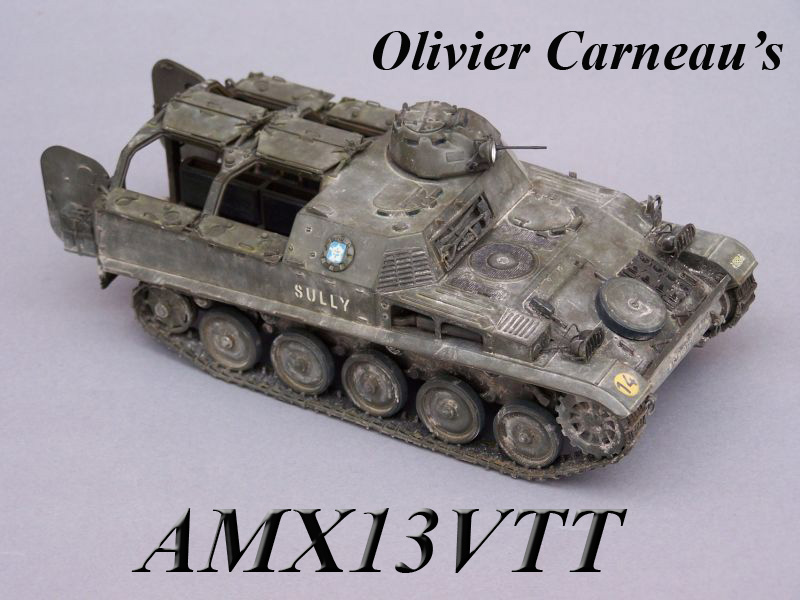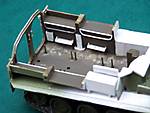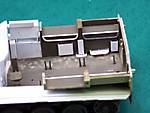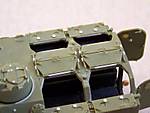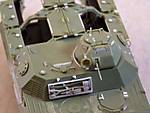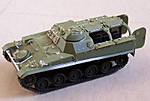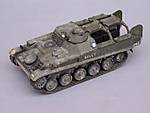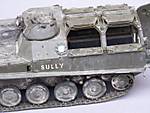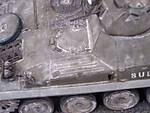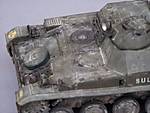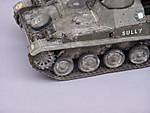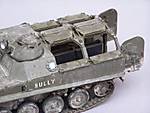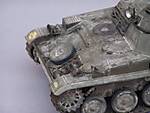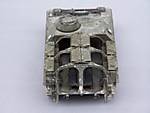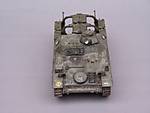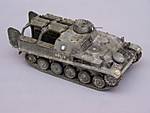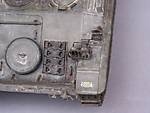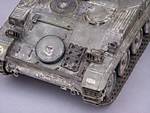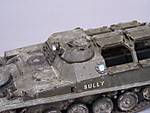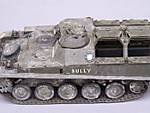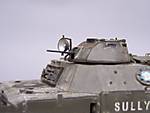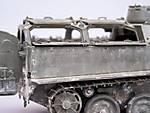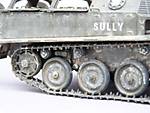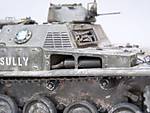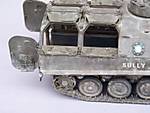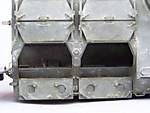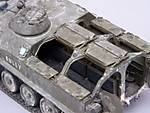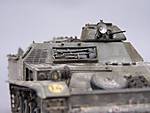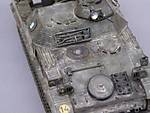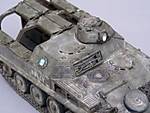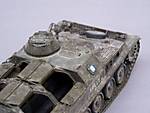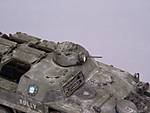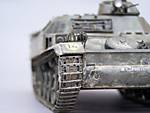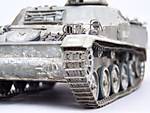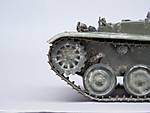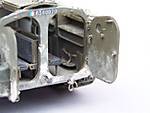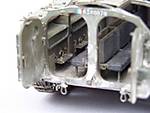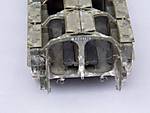1⁄35AMX13VTT
4
Comments
Background
The AMX13 VTT (APC) was a 14-ton armored vehicle based on the AMX13 family chassis. It could carry 12 soldiers plus the driver. Entered into service in 1967, it equipped the mechanized infantry units and some tank units. Protected against the effects of NBC weapons, it initially mounted a cupola fitted with a 7.5mm AA52 MG then the following versions mounted a 0.5cal MG and later a 20mm cannon.- Length : 5,59 m.
- Width : 2,51 m.
- Height : 2,40 m Speed : 60 km/h.
The kit
The kit #81140 from Heller depicts an early model. It comes with- 8 green plastic sprues
- 1 clear plastic sprue
- 1 vinyl sprue for the tracks and the tow cables
- 1 sheet of decals for one decoration
- A length of metallic wire for the antenna
The building
The chassis The building starts with the chassis without any major difficulty. The lower hull is divided in 6 parts (the front lower glacis, the sides, the rear wall and 2 parts for the floor!). The sprockets are enhanced with the addition of bolts on the outer ring. The resin tracks are lengthened by casting the missing links then set in place after a basic painting. The interior The most difficult is to find the necessary documentation. The pictures on the internet are rare. The bench seats are thinned and engraved to "break" their smooth look. The sides are detailed with various stowage bins and racks and their latches. To the front, the radio set support is added with its power cable and other cables. The vision blocks are filled with plastic card. The interior is painted white from the engine wall to the hatches and XF-62 green for the troop compartment.The exterior
The hull front The exterior detailing starts with the front glacis. Heller modeled two recessed hatches. New hatches are made from thin plastic card so as they are flush with the glacis. 4 bolts are added at the corners. On the contrary, the engine access hatch is molded with a raised lip. This lip must be sanded away and a recessed line is carved. The driver hatch is detailed and the hinge redone as it does not match the available pictures. The front splash-guard is replaced by another made from thin plastic card. The fixation system is added. It comprises bolted triangular parts on the sides and two stiffeners in the center. The most difficult is to redo the headlights protections. The ones in the kit are too thick and extremely simplified. After a long search for the needed documentation, the headlights supports are in their turn done with brass wire firstly shaped then flattened. The driver mirror protection is of a wrong model and replaced by one done with Evergreen strips. On the spare road wheel cover, one half-moon shaped handle is added. The pioneer tools support is fully redone from styrene trips, the tools come from various references. Above the support, the stops for the upper hatch are added. On the hatch itself, a strip of rubber is made from styrene strip carved with a cutter tip. The cupola The cupola is detailed too. In front of the gunner sight 2 tiny holes are drilled. On the hatches, the bolts are redone. Between the 2 right side vision blocks, the hatches unlocking button is added. The searchlight is drilled out. The bulb is added as well as the glass which is made from clear plastic. The wing nuts are added to the bracket. Finally the power cable is added. The MG barrel is changed as the kit one is not correct. The barrel from the AA52 of one soldier of the kit is used. A gap under the barrel is filled with a bit of thick plastic card. At last, the elevation limitation system is added between the right side of the cupola and the searchlight bracket. At the lowest elevation and when the cupola is traversed, the limitation arm makes contact with a rail around the cupola base on the roof and prevents the gunner from firing at the latter. To represent the rail, a strip is added. The ends must be angled. The upper hull The roll bars on the roof are thinned and detailed with the addition of one hinge and 2 plastic card rectangles per roll bar. All the hatches are detailed. First of all, the locking handles are removed. After the hatches have been thinned, they are glued again. The bars between the hinges are replaced by bits of plastic rod. The centre handles are made from brass rod. On the lower hatches, each firing port is thinned and gets its round shaped handle. The stops on the hull are shortened so as the open hatches are horizontal. Similarly, the grab handle between the stops is made from brass wire with a height enabling the horizontal position of the open hatches. The hull sides are detailed with eyelets for latches. On the right side, the exhaust cover is thinned from inside and gets 4 missing bolts. On the left side, one handle is added in the hollow as well as 5 bolts. The parts #74 are not glued directly to the hull. One gap must be created as in reality they rest on tiny bits of metallic tube. The right one is located slightly forward as compared to the kit instructions. 6 tiny plastic parts are placed in pair and triangle to the left of each part #74. They are brackets for retaining latches. The rear doors are thinned like the hatches. The mud flaps are thinned as well. The real ones are thin sheets of metal assembled with eyelets what Heller represented on the outer face. The towing hook is replaced by one from the spare parts box. Finally the exhaust is drilled.Painting and decaling
Concerning the decoration, the choice is scarce. Nonetheless, one can represent the model under the French or Belgian colors. In this case, you'll need to create the markings on your own. So I chose the French decoration given by Heller. It represents an APC from the 5th mechanized infantry regiment belonging to the 2nd AD. The shade is Tamiya XF-62. The decals are set after the model is sprayed with gloss varnish. The 2nd AD insignias are wider than the parts they are applied too. So they need to be cut. The rest comes without any problem. The light effects are made by melting oil paint spots of various shades then the dusty look due to the chalk of the Champagne training camps is realized with pigments from the brand Rembrandt.Conclusion
This kit shows its age but in a way it looks better than Heller's latest kits! Itís a pity that Heller didnít make some efforts to upgrade it for example with some PE parts like in their AMX30 series or a much complete decal sheet. However, it remains a very good base that I would recommend preferably to modelers having access to good pictures to detail it. If it is quite buildable from the box, getting the (not perfect) Trakpax tracks is a must. Anyway I had a lot of fun during this project and quite as much during my search for the right needed picture as for the assembly per se."Comments
Nice job Olivier, it's nice to see some of these older kits being built and displayed.
FEB 15, 2009 - 06:18 AM
Nice build, Oliver. A nice job on the interior. A little too dusty for my taste, but it is probably how a dusty AMX would look after a short Summer shower. So it is realistic in my opinion.
Thanks for sharing
FEB 18, 2009 - 02:25 AM
Nice work and very educating too! I've never heard of this vehicle and it's nice to see something other than tanks all the time.
FEB 18, 2009 - 03:46 AM
Thank you all for your kind comments.
Jesper I can guarantee you that in the Champagne training facilities a vehicle can quickly turn way much dustier than my little AMX
Dave and Jeff, you're right about seeing something different. I feel that way too. Even if I do widespread vehicles, I also like to find some less "modeled" ones. If you like that, stay tuned, sometimes my 2S9 and Skot2A should pop up !
FEB 18, 2009 - 04:45 AM
Copyright ©2021 by Olivier Carneau. Images and/or videos also by copyright holder unless otherwise noted. The views and opinions expressed herein are solely the views and opinions of the authors and/or contributors to this Web site and do not necessarily represent the views and/or opinions of Armorama, KitMaker Network, or Silver Star Enterrpises. All rights reserved. Originally published on: 2009-02-15 00:00:00. Unique Reads: 15148




